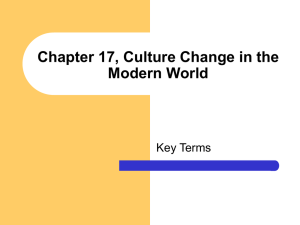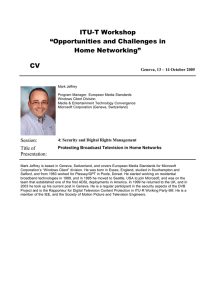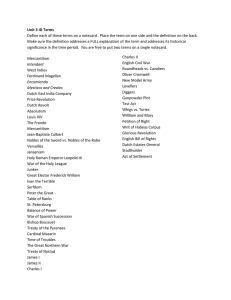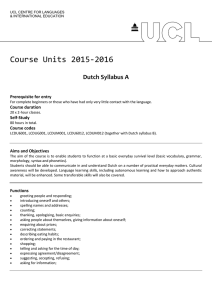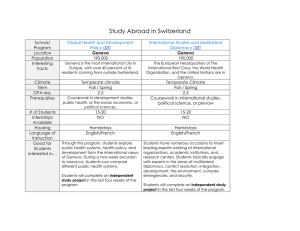Proceedings of Annual Switzerland Business Research Conference
advertisement
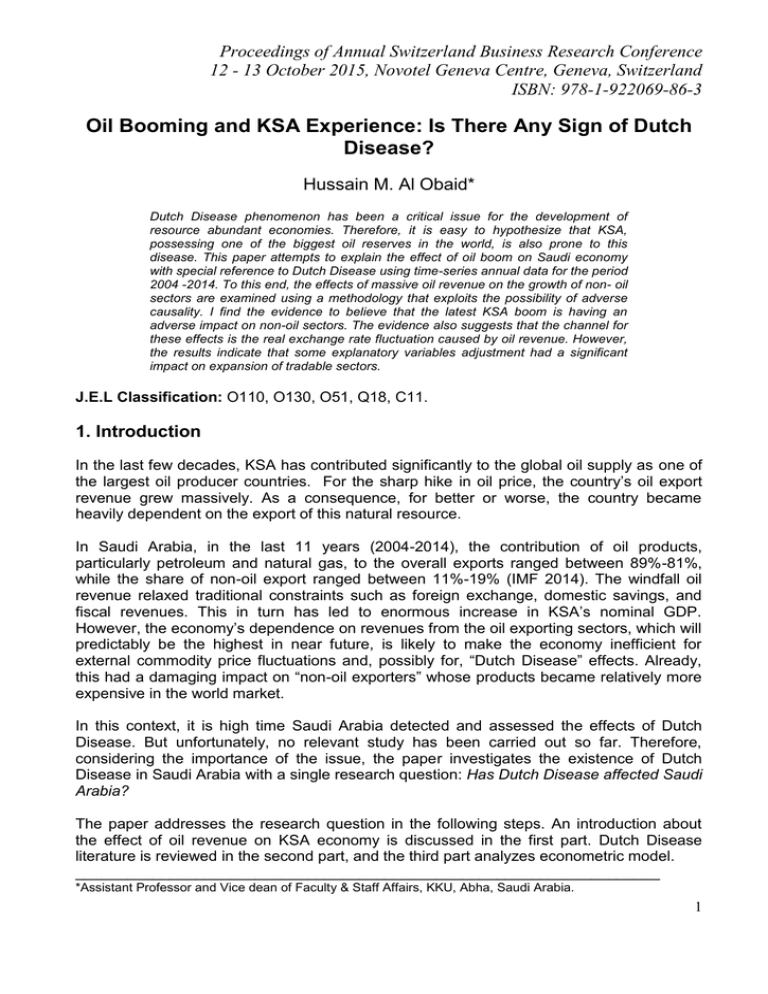
Proceedings of Annual Switzerland Business Research Conference 12 - 13 October 2015, Novotel Geneva Centre, Geneva, Switzerland ISBN: 978-1-922069-86-3 Oil Booming and KSA Experience: Is There Any Sign of Dutch Disease? Hussain M. Al Obaid* Dutch Disease phenomenon has been a critical issue for the development of resource abundant economies. Therefore, it is easy to hypothesize that KSA, possessing one of the biggest oil reserves in the world, is also prone to this disease. This paper attempts to explain the effect of oil boom on Saudi economy with special reference to Dutch Disease using time-series annual data for the period 2004 -2014. To this end, the effects of massive oil revenue on the growth of non- oil sectors are examined using a methodology that exploits the possibility of adverse causality. I find the evidence to believe that the latest KSA boom is having an adverse impact on non-oil sectors. The evidence also suggests that the channel for these effects is the real exchange rate fluctuation caused by oil revenue. However, the results indicate that some explanatory variables adjustment had a significant impact on expansion of tradable sectors. J.E.L Classification: O110, O130, O51, Q18, C11. 1. Introduction In the last few decades, KSA has contributed significantly to the global oil supply as one of the largest oil producer countries. For the sharp hike in oil price, the country’s oil export revenue grew massively. As a consequence, for better or worse, the country became heavily dependent on the export of this natural resource. In Saudi Arabia, in the last 11 years (2004-2014), the contribution of oil products, particularly petroleum and natural gas, to the overall exports ranged between 89%-81%, while the share of non-oil export ranged between 11%-19% (IMF 2014). The windfall oil revenue relaxed traditional constraints such as foreign exchange, domestic savings, and fiscal revenues. This in turn has led to enormous increase in KSA’s nominal GDP. However, the economy’s dependence on revenues from the oil exporting sectors, which will predictably be the highest in near future, is likely to make the economy inefficient for external commodity price fluctuations and, possibly for, “Dutch Disease” effects. Already, this had a damaging impact on “non-oil exporters” whose products became relatively more expensive in the world market. In this context, it is high time Saudi Arabia detected and assessed the effects of Dutch Disease. But unfortunately, no relevant study has been carried out so far. Therefore, considering the importance of the issue, the paper investigates the existence of Dutch Disease in Saudi Arabia with a single research question: Has Dutch Disease affected Saudi Arabia? The paper addresses the research question in the following steps. An introduction about the effect of oil revenue on KSA economy is discussed in the first part. Dutch Disease literature is reviewed in the second part, and the third part analyzes econometric model. ____________________________________________________________________ *Assistant Professor and Vice dean of Faculty & Staff Affairs, KKU, Abha, Saudi Arabia. 1 Proceedings of Annual Switzerland Business Research Conference 12 - 13 October 2015, Novotel Geneva Centre, Geneva, Switzerland ISBN: 978-1-922069-86-3 The fourth part explains the specific details about estimation using EViews. Finally, the result is explained in the fifth part as a conclusion. 2. Literature Review The term Dutch Disease comes from a 1977 article in The Economist (26 Nov 1977) which describes the shrinking of the Netherlands’ manufacturing sector following the discovery of important reserves in natural gas. The decline in the Netherlands’ export competitiveness followed the discovery of the Groningen gas fields in the early 1970s (Kremers 1986). In another way, Dutch Disease simply means the coexistence of booming and lagging sectors in an economy due to a temporary or sustained increase in export earnings. This economic phenomenon has been investigated in the perspective of the Dutch Disease, which refers to the negative effects that an export boom may have on tradable sectors. Also, Dutch Disease can be characterized by an increase in the real exchange rate as well as the reduction of some sectors due to the loss in competitiveness. When some sectors lose competitiveness, it means there is decline in their output, investment and income. In short, if a country is affected by Dutch Disease, part of its enormous revenue is spent on the nontradable goods that leads to an appreciation of the real exchange rate, which in turn draws resources out of the tradable sector into the non-tradable sector causing “spending effect”. The “spending effect” refers to the further reduction of tradable sectors due to the appreciation of the real exchange rate. In other words, the rise in the relative price of nontradable goods increases the relative profitability of the non-tradable goods sector. This phenomenon enjoyed a stimulation of interest in the 1970s, as rising oil and gas prices enriched the exporting countries with substantial wealth. The enormous wealth exerted a negative influence on a certain part or on the economy of the oil-rich nations due to the 2 Proceedings of Annual Switzerland Business Research Conference 12 - 13 October 2015, Novotel Geneva Centre, Geneva, Switzerland ISBN: 978-1-922069-86-3 failure of economic policy in dealing with the windfall profit from increased price of natural resource. van Wijnbergen (1984), Krugman (1987), Matsuyama (1992) and Gylfason et al. (1999) show that an abundance of natural resources shifts factors of production out of sectors where production exhibits static or dynamic increasing returns to scale. They also suggest that an abundance of natural resources might shift factors of production away from those sectors, pushing down productivity growth. Krugman (1987) states that Dutch Disease refers to the case where a resource boom in an economy leads to a real exchange rate appreciation and to the crowding out of the tradable manufacturing sector. According to Krugman, it becomes a disease when the manufacturing sector does not recover after the resource boom. Auty (1994, p. 14) observes, “The mineral economies have underperformed compared with countries of a similar size and level of economic development, which lack the mineral bonus ". However, the manufactured traded goods sector actually expanded in most developing oil exporting countries following the oil boom, whereas the agricultural traded goods sector contracted in all cases (World Bank 1984). Although this phenomenon is generally associated with the discovery and export of natural resources, it can be caused by any economic change—like a significant increase in export prices, FDI or aid flows—which makes the foreign exchange more available to national economy (Edwards & van Wijnbergen 1989 & Adam 2005). However, in the case of oilexporting countries, enormous foreign currency revenue from exporting oil commodities was repeatedly spent for the investment of the development of the oil production and thus the exchange rate rose. Therefore, if there is an essential problem arising from the Dutch Disease, it is resource reallocation and the burden of adjustment, at least from the point of the losing factors (Corden 1984). 3 Proceedings of Annual Switzerland Business Research Conference 12 - 13 October 2015, Novotel Geneva Centre, Geneva, Switzerland ISBN: 978-1-922069-86-3 The “Dutch Disease” literature states that a natural resource boom might also play as a development curse, which is termed as the resource curse by Auty (1993). Auty (2001) shows that between 1960 and 1990 income per capita has grown much faster in nonnatural resource exporting countries than the mineral products producing countries. Sachs and Warner (1999) find that countries with high resource-exports-to-GDP ratios experience lower growth rates. Studies by van Wijnbergen (1984), Krugman (1987), Matsuyama (1992), Sachs and Warner (1995) and Gylfason et al. (1999) find that when the exploitation of more natural resources shrinks the tradable sector and Learing By Doing (LBD), it reduces productivity growth. The Dutch Disease literature, except Torvik (2001), assumes that LBD generates productivity growth in the tradable sector only. van Wijnbergen (1984), Krugman (1987), Matsuyama (1992) and Gylfason et al. (1999) assume that LBD only benefits the sector where it is generated, while productivity in the rest of the economy is constant. Bardhan (1970) analyzes trade and industrial policy in the presence of learning effects. His model is, however, oriented more towards development policy in small LDCs than towards the issues addressed in this paper. Sachs and Warner (1995) assume that LBD benefits both the traded and non-traded sectors in a balanced way. Dutch Disease is also studied in one-sector endogenous growth model with rent-seeking (Lane and Tornell 1996), and in an agriculture/industry model in which both goods are tradable (Matsuyama 1992). The most important contribution to the Dutch Disease with endogenous productivity is the two-period model by van Wijnbergen (1984), where the second period productivity in the traded sector depends on the first period production of traded goods. Matsuyama (1992) states that the resource abundance effect in each period is also exogenous in and represented by the productivity of land. Rodriguez and Sachs (1998) also discuss a model with exogenous productivity growth. They also assume that 4 Proceedings of Annual Switzerland Business Research Conference 12 - 13 October 2015, Novotel Geneva Centre, Geneva, Switzerland ISBN: 978-1-922069-86-3 the current account is exogenous. Krugman (1987), Sachs and Warner (1995), Gylfason et al. (1999) and Torvik (2002) consider an exogenous flow of resource income in each period and trace out the growth effects. Gylfason et al. (1997) extend the literature by studying how Dutch Disease affects exchange rate, and thereby investment and productivity growth. In contrast to Dutch Disease theory, Krugman (1987) states that in the late nineteenth century California State was a resource based economy with little growth in manufacturing industries because of the local market limitation. He points out that for the discovery of oil, California rapidly emerged as a state of massive growth and as an industrial hub. Benjamin, Devarajan and Weiner (1988) explain the massive growth of the manufacturing sector by relaxing the assumption of perfect substitutability between domestically produced and imported manufactured goods. They find that increased national income expands domestic manufactured output by raising its domestic relative profitability. Fardmanesh (1990) provides another explanation for the manufacturing sector expansion. He states that the domestic relative price of manufactured goods rises in the developing oil-exporting economy since it is a price taker in the world of non-oil markets. However, Sachs and Warner (1995) provide evidence for the depressive effect of natural resource abundance on growth in their regression analysis based on the cross-country growth data. In a similar vein, Mansoorian (1991), in his empirical study, discusses why a resource discovery may lead to extreme borrowing, and investigates the short and long run economic consequences in this case. Nevertheless, Graham (1995) investigates the basic recognition implied in the resource curse thesis and suggests that the thesis is not a wellknown and general phenomenon. 5 Proceedings of Annual Switzerland Business Research Conference 12 - 13 October 2015, Novotel Geneva Centre, Geneva, Switzerland ISBN: 978-1-922069-86-3 Considering the “spending effect” (Corden and Neary 1982), the core model of Dutch Disease concludes that the oil boom undermines the non-oil traded goods sectors and expands the non-tradable goods sector (van Wijnbergen 1984). The higher wages are spent raising the price of non-traded goods relative to traded goods and the real exchange rate. Thus, they can reduce the traded sector competitiveness. Therefore, it is really difficult to address the Dutch Disease issue. Although, there are many suggestions regarding policy responses to this problem, they are still open to further research (Mainardi 1995). In the case of Saudi Arabia, so far, no study has been carried out in order to assess the Dutch Disease effects. Having the greatest oil reserves in the world, the Kingdom is supposed to be more prone to this fatal disease than any other state. It is high time Saudi Arabia located the disease affected areas and stopped its spread. Although some steps taken by the government seem to be precautionary measures against the disease, no wellplanned policy has yet been made. At this critical point, this study has been carried out to wake the policy makers up to this serious issue. 3. The Methodology and Model Dutch Disease can be explained in line with macroeconomics, involvement of government spending, and net export. This paper is based on the well-known Dutch Disease related economic models developed by W. M. Corden and J. P. Neary in the 1980s. The Dutch Disease, in their model, means the negative effects of the natural gas discoveries in the 1970s on the other Dutch manufacturing industries through the following appreciation of the Dutch real exchange rate. Their model states that this happened in the Netherlands because of the inappropriate use of booming sector revenue for enriching the other sectors. 6 Proceedings of Annual Switzerland Business Research Conference 12 - 13 October 2015, Novotel Geneva Centre, Geneva, Switzerland ISBN: 978-1-922069-86-3 In this part, I will give the technical details regarding estimations. The EViews is used as the only tools for the process of making econometric analyses. The analyses are done according to the time series estimations with annual 11 samples in each variable. The period is from 2004 to 2014 and the data covered all the concerned events such as the oil boom and the economic crisis. The method for estimation is Ordinary Least Squares. The symbolic names of each variable used in the estimations are as follows: Gross Domestic Product (GDP) (dependent variable), Oil Export (OX), the Non-oil Export (NOX), Inflation Rate (INF) and Exchange Rate (XCH) (explanatory variables). Specifically, this paper aims at examining whether Dutch Disease exists in Saudi Arabia or not and if it exists, how it affects the other non-oil sectors. The correlations are measured in terms of econometrics using the existing statistical data regarding KSA economy. The primary data used for this paper were collected from three sources; SAMA’s 50th Annual Report, World Bank and IMF. Annual data of the last 11 years (2004-2014) were obtained in terms of GDP, OX, NOX, INF and XCH. All data have been converted into real terms and transformed into logarithms. 7 Proceedings of Annual Switzerland Business Research Conference 12 - 13 October 2015, Novotel Geneva Centre, Geneva, Switzerland ISBN: 978-1-922069-86-3 Figure 1: Comparison between oil and non-oil export (SR) during 2004-2014 Figure 2: Rise and fall of inflation rate during 2004-2014 8 Proceedings of Annual Switzerland Business Research Conference 12 - 13 October 2015, Novotel Geneva Centre, Geneva, Switzerland ISBN: 978-1-922069-86-3 Figure 3: Rise and fall of exchange rate in the period between 2004-2014 In this part, I will try to discuss Dutch Disease by presenting a framework that explains the macroeconomic reasoning behind the concept. The model constructed on the basis of Nkusu (2004) uses the assumptions of the Dutch Disease model developed by Corden and Neary (1982). Applying to economic models mentioned before, the econometric model and its expected consequence are as follows: GDP = OX GDP = α + β1OX + + NOX + β2NOX INF + + β3INF XCH + (1) β4XCH + Ԑ (2) GDP: Gross Domestic Product, OX: Oil export, NOX: Non-Oil Export, INF: inflation rate, XCH: exchange rate, α: constant term, β1, … β4: parameters and Ԑ: error term. 9 Proceedings of Annual Switzerland Business Research Conference 12 - 13 October 2015, Novotel Geneva Centre, Geneva, Switzerland ISBN: 978-1-922069-86-3 The analyses are constructed according to the time-series estimations with annual 11 samples in each variable at any estimation. The certain time period (2004-2014) is chosen for two reasons: firstly, this is the time when oil boom happened and secondly, the data are available. The method for estimation is Ordinary Least Squares. 4. The Findings As can be seen in the table below, the negative correlation between Oil export and GDP can be considered as an explanation of the Dutch Disease. Likewise, the coefficient of exchange rate is significantly negative, which means when the exchange rate goes down, GDP grows. The results of alternative versions of equation 2 are presented in Table 1: Table 1: Results of alternative versions of equation 2 Dependent Variable: GDP Method: Ordinary Least Squares Date:07/09/2015 Time:06:44 Sample: 2004 - 2014 Included observations: 11 Variable Coefficient Std. Error t-Statistic Prob. C 1324291.2 264271.39 5.470569 0.00000 OX -2.034227 1.916852 -2.037331 0.00130 NOX 8.530599 3.150443 2.707746 0.00330 XCH -1.7683212 1.512712 -1.168349 0.00890 10 Proceedings of Annual Switzerland Business Research Conference 12 - 13 October 2015, Novotel Geneva Centre, Geneva, Switzerland ISBN: 978-1-922069-86-3 INF 7.796509 4.736510 0.164759 0.07380 R-squared 0.831533 Adjusted R-squared 0.798333 In the results, the adjusted R2 shows that the estimated model explains about 80% of the variation in the dependent variable. Therefore, these results should be interpreted carefully. Based on Granger Causality Test, the reported F-statistics is a joint test for joint hypothesis that Oil Export (OX) does not Granger cause GDP. The probability for accepting the null hypothesis is only 0.04%, while 99.96% reject this hypothesis. This means that OX consistently causes GDP by around 99.96% all the time in the case of Saudi Arabia. However, the results present feedback causality (bidirectional) from GDP to OX, where the probability for accepting the null hypothesis is only 9.48%, while 90.62% indicate rejection of the hypothesis, which means GDP consistently causes OX by around 90.62% all the time in the case of Saudi Arabia. In addition, the reported F-statistics is a joint test for joint hypothesis that Non-Oil Export (NOX) does not Granger cause GDP. The probability for accepting the null hypothesis is only 3.20%, while 96.80% reject this hypothesis. This means that NOX consistently causes GDP by around 96.80% all the time in the case of Saudi Arabia. However, the results present a week feedback causality (bidirectional) from GDP to NOX, where the probability for accepting the null hypothesis is only 54.29%, while 45.71% indicate rejection of the hypothesis, which means GDP consistently causes NOX by only 45.71% all the time in the case of Saudi Arabia. 11 Proceedings of Annual Switzerland Business Research Conference 12 - 13 October 2015, Novotel Geneva Centre, Geneva, Switzerland ISBN: 978-1-922069-86-3 Table 2: The contribution of OX and NOX to GDP Prob. F-Statistics Obs Null Hypothesis 0.0004 93.4389 9 0.0948 4.49623 9 GDP does not Granger Cause OX 0.0320 9.18348 9 NOX does not Granger Cause GDP Bidirectional 0.5429 0.71440 9 GDP does not Granger Cause NOX (Week) OX does not Granger Cause GDP Causality Direction Bidirectional (Strong) However, it would be unjustified to interpret the results suggesting that any real appreciation in the country was due only to the transitional factors and that KSA over the medium and long term is not vulnerable to Dutch Disease. Given that oil will play an even greater role in the KSA’s economy and exports in the future (IMF 2014), the impact of the terms of trade on the real exchange rate of similar magnitude or larger in the future should be expected. Thus, Dutch Disease-type structural relationships are likely to occur in the future. Therefore, it is critically important to design suitable macroeconomic policies to deal with such issues. Fortunately, although KSA invested a huge amount of money in oil sector, the results of this study imply that the Kingdom used its oil revenue to strengthen the production base of the tradable sector such as agriculture and manufacturing which could have been possibly damaged by the Dutch Disease effects by this time. 12 Proceedings of Annual Switzerland Business Research Conference 12 - 13 October 2015, Novotel Geneva Centre, Geneva, Switzerland ISBN: 978-1-922069-86-3 5. Summary and Conclusions The conclusion, with regard to the single research question, with some caveats described below, is as follows—although the symptoms are not very obvious, Saudi Arabia is suffering like other oil-rich countries from Dutch Disease. Using a methodology that exploits the possibility of adverse causality, the paper investigates the effects of massive oil revenue on the growth of non- oil sectors and finds that the latest KSA oil-boom had an overall adverse impact on non-oil sectors. Although the contribution of non-oil sectors to Saudi GDP has been increasing for the last 11 years, the paper concludes that the non-oil sectors would perform much better if the Dutch Disease effects could be avoided. The study is not without limitations. The statistical findings would be more valid if the study were conducted with longer time period and more data. Moreover, a detailed comparison between Saudi Arabia and other Dutch Disease affected oil-rich countries would give us clearer picture about the exact point where Saudi Arabia stands right at this moment, and what steps it should take in order to be cured of this fatal disease. Nevertheless, despite these limitations, the results of this study have some practical implications. They can wake the state authority up to the still indistinct symptoms of the Dutch Disease, so that they can take some short-term precautionary measures to stop its spreading and long-term far-sighted steps to be permanently cured of it. For example, if the government spends more for infrastructural development and increases the subsidy to the farmers, industrialists, and other entrepreneurs, the non-oil sectors will be more productive and competitive. 13 Proceedings of Annual Switzerland Business Research Conference 12 - 13 October 2015, Novotel Geneva Centre, Geneva, Switzerland ISBN: 978-1-922069-86-3 References Adam, CS 2005, ‘Exogenous inflows and real exchange rates: theoretical Quirk or Empirical Reality?’, paper presented in a seminar on foreign aid and macroeconomic management, Maputo, march 14-15. Auty, RM 1993, Sustaining development in mineral economies: the resource curse thesis, Routledge, London. Auty, RM 1994, ‘Industrial policy reform in six large newly industrializing countries: the resource curse thesis,’ World Development, vol. 22, pp. I I-26. Auty, RM 2001, Resource abundance and economic development, Oxford University Press, Oxford. Bardhan, P 1970, Economic growth, development, and foreign trade, Wiley, New York. Behrman, JR 1987, ‘Commodity price instability and economic goal attainment in developing countries,’ World Development, vol.15, pp. 559-573. Benjamin, NC, S Devarajan, & RJ Weiner 1988, “The 'Dutch Disease' in a developing country: oil reserves in Cameroon,” Journal of Development Economics, vol. 30, no. 1. Bevan, D, Collier, P & Gunning, JW 1987, ‘Consequences of a commodity boom in a controlled economy: accumulation and redistribution in Kenya, 1973-1983’, World Bank Economic Review, vol. 3, no. 1, pp. 489-513. Bevan, D, Collier P, & Gunning, JW 1989, ‘Fiscal response to a temporary trade shock: the aftermath of the Kenyan coffee boom’, World Bank Economic Review, vol. 3, pp. 359378. Bevan, D, Collier P, & Gunning, JW 1989, ‘Anatomy of a temporary trade shock: the Kenyan coffee boom of 1976-79’, Journal of African Economies, vol. 1, no. 2, pp. 271305. Cordon, WM & JP Neary 1982, ‘Booming sector and deindustrialization in a small open economy’, Economic Journal, vol. 92. Corden, WM 1984, ‘Booming sector and Dutch disease economics: Survey and consolidation,’ Oxford EconomicPapers, vol. 36, no. 3, pp. 359-380. Davies, R, Rattso, J, & Torvik, R 1994, ‘The macroeconomics of Zimbabwe in the 1980s: a CGEmodel analysis’, Journal of African Economies, vol. 3, pp. 153-198. Davis, GA 1995, ‘Learning to love the Dutch Disease: evidence from the mineral economies’, World Development, vol. 23, no. 10, pp.1765-1779. 14 Proceedings of Annual Switzerland Business Research Conference 12 - 13 October 2015, Novotel Geneva Centre, Geneva, Switzerland ISBN: 978-1-922069-86-3 Edwards, S, van Wijnbergen, S 1989, ‘Disequilibrium and structural adjustment’ in H Chenery and TN Srinivasan (eds.), Handbook of Development Economics, vol. II, Amsterdam, North-Holland, pp. 213-221. Fardmancsh, M 1990, ‘Terms of trade shocks and structural adjustment in a small open economy: Dutch Disease and oil price increases,’ Journal of Development Economics, vol. 34, no. 1/2, pp. 339-353. Gelb, AH 1986, ‘Adjustment to windfall gains: a comparative analysis of oil- exporting countries,’ in Neary JP & van Wijnbergen S (eds.) Natural Resources and the Macroeconomics, Basil Blackwell, Oxford & Cambridge, MIT Press, Mass. Graham, D 1995, ‘Learning to love the Dutch disease: evidence from the mineral economies,’ World Development, vol. 23, pp. 1765-1779. Gylfason, T, Herbertson, TT, & Zoega, G 1997, ‘A mixed blessing: natural resources and economic growth,’ Discussion paper no. 1668. CEPR, London. Gylfason, T, Herbertsson, TT, & Zoega, G 1999, ‘A mixed blessing: natural resources and economic growth,’ Macroeconomic Dynamics, vol. 3, pp. 204– 225. International Monetary Fund (IMF) 2014, 2014 spillover report, viewed 24 August 2015, http://www.imf.org/external/np/pp/eng/2014/062514.pdf. Hannesson, R 2001, Investing for sustainability: the management of mineral wealth, Kluwer Academic Publishers, Boston. Kremers, Jeroen JM 1986, ‘The Dutch disease in the Netherlands,’ in J Peter Neary and S van Wijnbergen (eds.), Natural Resources and the Macroeconomy, The MIT Press, Cambridge, pp. 96-136. Krugman, P 1987, ‘The narrow moving band, the Dutch disease, and the competitive consequences of Mrs. Thatcher: notes on trade in the presence of dynamic scale economies,’ Journal of Development Economics, vol. 37, pp. 41– 55. Leaderman D & Maloney WF 2003, ‘Trade structure and growth,’ World Bank Policy Research working paper. 3025. Lane, PR, Tornell, A 1996, ‘Power, growth and the voracity effect,’ Journal of Economic Growth,vol.1, pp. 213– 241. Lewis, A 1955, The theory of economic growth, Allen and Unwin, London. Mainardi, S 1995, ‘Mineral resources and growth: toward a long-term convergence,' Resources Poli 0", vol. 21, pp. 155-163. Mansoorian, A 1991, “Resource discoveries and ‘excessive’ external borrowing,” Economic Journal, vol. 101, pp. 1497-1509. 15 Proceedings of Annual Switzerland Business Research Conference 12 - 13 October 2015, Novotel Geneva Centre, Geneva, Switzerland ISBN: 978-1-922069-86-3 Marquez, J 1985, ‘Foreign exchange constraints and growth possibilities in the LDCs,’ Journal of Development Economics, vol. 19, pp. 39-57. Matsuyama, K 1992, ‘Agricultural productivity, comparative advantage and economic growth,’ Journal of Economic Theory, vol. 58, pp. 317-334. McKinnon, RI 1976, ‘International transfers and non-traded commodities: the adjustment problem,’ in D Leipziger (ed.), The International Monetary System and the Developing Nations, Agency for International Development, Washington, DC. Neary, JP & S van Wijnbergen (eds.) 1986, Natural Resources and the Macroeconomy, MIT Press, Cambridge. Nkusu, M 2004, ‘Aid and the Dutch Disease in low-income countries: informed diagnoses for prudent prognoses,’ IMF Working paper no. 49, viewed 24 August 2015, https://www.imf.org/ external/pubs/ft/ wp/2004 /wp0449.pdf. Rodriguez, F & Sachs, J 1998, ‘Why do resource-abundant economies grow more slowly?’ Journal of Economic Growth, vol. 4, pp. 277– 303. Røed LE 2003, ‘Are rich countries immune to the resource curse? Evidence from Norway’s managment of its oil riches,’ discussion paper no. 362, Statistics, Norway, viewed 24 August, http:// www.sciencedirect. com/science/ article/ pii/ S0301420705000024. Roemer, M 1985, ‘Dutch disease in developing countries: swallowing bitter medicine,’ in Mats Lundahl (ed.), The Primury Sector in Economic Development, Croom Helm, London, pp. 234-252. SAMA’s 50th 2015, ‘Saudi Arabian Monetary Agency- 50th annual report,’ viewed 24 August 2015, www.sama.gov.sa/en-US/EconomicReports /Ann ual Report/ 5600_R_Annual_En_50_Ap... Sachs, JD & Warner, AM 1995, ‘Natural resources abundance and economic growth,’ NBER Working Paper No. 5398, National Bureau of Economic Research, Cambridge MA. Sachs, JD & Warner, AM 1999, ‘The big push, natural resource booms and growth,’ Journal of Development Economics, vol. 59, pp. 43– 76. Torvik, R 2001, ‘Learning by doing and the Dutch disease,’ European Economic Review, vol. 45, pp. 285–306. Torvik, R 2002, ‘Natural resources, rent seeking and welfare,’ Journal of Development Economics, vol. 67, pp. 455– 470. van Wijnbergen, S 1984, ‘The Dutch disease: a disease after all,’ Economic Journal, vol. 94, pp. 41–55. 16 Proceedings of Annual Switzerland Business Research Conference 12 - 13 October 2015, Novotel Geneva Centre, Geneva, Switzerland ISBN: 978-1-922069-86-3 World Bank 1984, World Tables , The World Bank, Washington, DC. Appendix Saudi GDP, OX, NOX, INF, and XCH during 2014-2014 17
